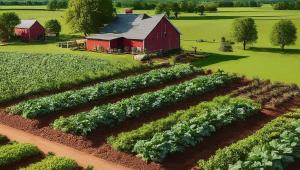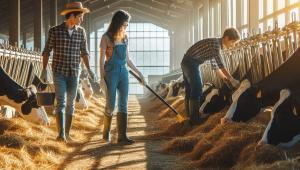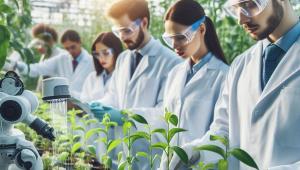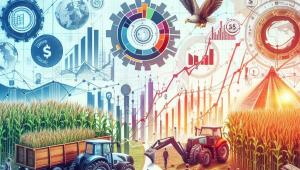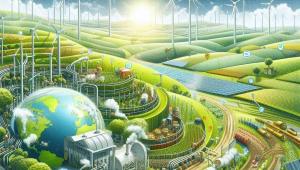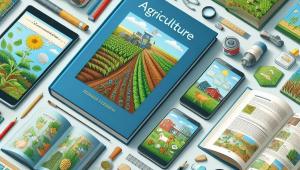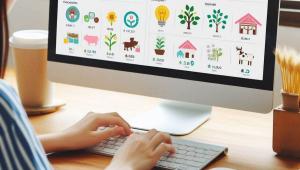A food system encompasses all the elements and activities involved in the production, processing, distribution, consumption, and disposal of food, as well as the social, economic, and environmental outcomes of these activities. It is a complex and dynamic network of actors, processes, and relationships that shape the way food is grown, moved, and consumed around the world.
In this comprehensive guide, we will explore the key components, drivers, and challenges of food systems, as well as the opportunities and strategies for creating more sustainable, equitable, and resilient food systems that nourish people and the planet.
Components of Food Systems
Food Production
Food production is the foundation of any food system, involving the cultivation of crops, the raising of livestock, and the harvesting of wild foods. It encompasses a wide range of activities, from small-scale subsistence farming to large-scale industrial agriculture, and is influenced by various factors such as climate, soil, water, technology, and management practices.
Some key issues and trends in food production include:
- Intensification and specialization of agriculture, leading to increased productivity but also environmental and social challenges
- Expansion of agricultural frontiers, particularly in tropical regions, leading to deforestation, biodiversity loss, and land degradation
- Adoption of new technologies, such as precision agriculture, genetic engineering, and vertical farming, with potential benefits and risks
- Diversification of production systems, such as agroecology, permaculture, and organic farming, emphasizing sustainability and resilience
Food Processing and Packaging
Food processing and packaging involve the transformation of raw agricultural products into value-added food products that are safe, convenient, and appealing to consumers. This includes activities such as milling, cooking, fermenting, preserving, and packaging foods, as well as the development of new food products and ingredients.
Some key issues and trends in food processing and packaging include:
- Increasing consolidation and globalization of the food processing industry, led to the dominance of a few large multinational corporations
- Growing demand for processed and packaged foods, particularly in urban and middle-income populations, with implications for diet quality and health
- Concerns about the safety and quality of processed foods, particularly about additives, contaminants, and allergens
- Development of new processing and packaging technologies, such as high-pressure processing, 3D printing, and edible coatings, with potential benefits and challenges
Food Distribution and Retail
Food distribution and retail involve the movement of food products from producers to consumers, through various channels such as wholesale markets, supermarkets, restaurants, and online platforms. This includes activities such as transportation, storage, marketing, and sale of foods, as well as the management of food waste and losses.
Some key issues and trends in food distribution and retail include:
- Increasing concentration and power of large food retailers and supermarkets, particularly in developed countries, with implications for food prices, quality, and access
- The growing role of food service and out-of-home consumption, particularly in urban areas, with implications for diet quality and health
- Emergence of new distribution and retail models, such as online grocery delivery, meal kits, and direct-to-consumer sales, with potential benefits and challenges
- Concerns about food waste and losses, particularly at the retail and consumer levels, with implications for food security and environmental sustainability
Food Consumption and Nutrition
Food consumption and nutrition involve the acquisition, preparation, and eating of foods, as well as the biological and social processes that influence these behaviors. This includes factors such as food preferences, dietary habits, cooking skills, and access to healthy and affordable foods, as well as the nutritional outcomes of these behaviors.
Some key issues and trends in food consumption and nutrition include:
- Increasing prevalence of overweight and obesity, particularly in developed and middle-income countries, with implications for diet-related chronic diseases
- Persistence of undernutrition and micronutrient deficiencies, particularly in low-income and vulnerable populations, with implications for child growth and development
- Changing dietary patterns and food preferences, particularly towards more processed and animal-source foods, with implications for environmental sustainability and animal welfare
- Growing interest in healthy and sustainable diets, such as plant-based, organic, and local foods, with potential benefits and challenges for food systems
Drivers of Food Systems
Food systems are shaped by a complex interplay of social, economic, and environmental drivers that operate at different scales and levels. These drivers influence the way food is produced, distributed, and consumed, as well as the outcomes of these activities for people and the planet.
Some key drivers of food systems include:
Population Growth and Urbanization
The world's population is projected to reach 9.7 billion by 2050, with most of this growth occurring in developing countries and urban areas. This demographic shift is driving increased demand for food, particularly processed and animal-source foods, as well as changing the way food is produced and distributed.
Urbanization is also changing the structure and function of food systems, with implications for food security, nutrition, and sustainability. For example, urban food systems are characterized by longer and more complex supply chains, greater reliance on food imports, and higher levels of food waste and packaging.
Economic Growth and Globalization
Economic growth and globalization are transforming food systems around the world, with both positive and negative impacts. On one hand, economic growth is increasing incomes and purchasing power, particularly in developing countries, leading to greater demand for and access to diverse and nutritious foods. On the other hand, globalization is leading to the concentration and consolidation of food systems, with a few large multinational corporations dominating the production, processing, and distribution of foods.
Globalization is also increasing the interconnectedness and interdependence of food systems, with implications for food security and resilience. For example, global trade in agricultural commodities can help to buffer against local production shocks and improve food availability and affordability. However, it can also expose food systems to global price volatility, supply chain disruptions, and geopolitical tensions.
Technology and Innovation
Technology and innovation are driving profound changes in food systems, from the development of new crop varieties and farming practices to the digitization and automation of food supply chains. Some key technological innovations in food systems include:
- Precision agriculture, using sensors, drones, and data analytics to optimize crop yields and resource use efficiency
- Genetic engineering and gene editing, developing new crop varieties with enhanced traits such as disease resistance, nutrient content, and climate resilience
- Cellular agriculture and alternative proteins, producing meat, dairy, and egg products from cell cultures or plant-based ingredients
- Blockchain and Internet of Things, enabling transparent and secure traceability of food products from farm to fork
While these technologies offer potential benefits for food systems, such as increased productivity, reduced environmental impact, and improved food safety and quality, they also raise important questions and concerns about their social, economic, and ethical implications.
Climate Change and Environmental Degradation
Climate change and environmental degradation are major threats to food systems, with far-reaching impacts on food production, distribution, and consumption. Rising temperatures, changing precipitation patterns, and increasing frequency and intensity of extreme weather events are already affecting crop yields, livestock productivity, and fisheries, particularly in vulnerable regions such as sub-Saharan Africa and South Asia.
At the same time, food systems are major contributors to climate change and environmental degradation, through greenhouse gas emissions, deforestation, water use, and pollution. Agriculture alone accounts for around one-quarter of global greenhouse gas emissions and is a major driver of biodiversity loss, soil degradation, and water scarcity.
Addressing the dual challenges of climate change adaptation and mitigation in food systems requires a fundamental transformation towards more sustainable and resilient practices, such as agroecology, climate-smart agriculture, and circular economy approaches.
Challenges and Opportunities in Food Systems
The complex and dynamic nature of food systems presents both challenges and opportunities for achieving sustainable, equitable, and healthy outcomes for people and the planet. Some key challenges and opportunities in food systems include:
Food Security and Nutrition
Ensuring food security and nutrition for all is a major challenge facing food systems, particularly in the context of population growth, climate change, and increasing inequality. While global food production has kept pace with population growth in recent decades, around 2 billion people still lack regular access to safe, nutritious, and sufficient food, and over 820 million people are undernourished.
At the same time, over 2 billion adults are overweight or obese, and diet-related chronic diseases such as diabetes, heart disease, and cancer are on the rise, particularly in developing countries. This "double burden" of malnutrition poses significant challenges for food systems, requiring a shift towards more diverse, nutritious, and affordable diets, as well as targeted interventions for vulnerable populations.
Some key opportunities for improving food security and nutrition in food systems include:
- Diversifying food production systems, particularly towards nutrient-dense crops such as fruits, vegetables, and legumes
- Improving the efficiency and effectiveness of food supply chains, particularly in reducing food loss and waste
- Enhancing the affordability and accessibility of healthy foods, particularly for low-income and marginalized populations
- Promoting nutrition education and behavior change, particularly around healthy and sustainable diets
Environmental Sustainability
Ensuring the environmental sustainability of food systems is a major challenge, given the significant impacts of food production, processing, and distribution on land, water, biodiversity, and climate. Agriculture alone accounts for around 70% of global freshwater withdrawals and is a major driver of deforestation, soil degradation, and biodiversity loss.
At the same time, food systems are highly vulnerable to the impacts of climate change and environmental degradation, particularly in regions with high levels of poverty and food insecurity. Rising temperatures, changing precipitation patterns, and increasing frequency and intensity of extreme weather events are already affecting crop yields, livestock productivity, and fisheries, with significant implications for food security and livelihoods.
Some key opportunities for improving the environmental sustainability of food systems include:
- Adopting sustainable and resilient farming practices, such as agroecology, conservation agriculture, and integrated pest management
- Reducing food loss and waste, particularly through improved storage, processing, and distribution technologies and practices
- Promoting sustainable and healthy diets, particularly through reducing meat consumption and increasing plant-based and alternative protein sources
- Investing in research and innovation for sustainable food systems, particularly in areas such as climate-smart agriculture, precision agriculture, and circular economy approaches
Social and Economic Equity
Ensuring social and economic equity in food systems is a major challenge, given the significant disparities in access to resources, opportunities, and benefits among different actors and groups. Small-scale farmers, women, youth, and indigenous peoples are often marginalized and disadvantaged in food systems, facing barriers such as limited access to land, credit, markets, and decision-making processes.
At the same time, food systems are a major source of livelihood and income for billions of people around the world, particularly in developing countries where agriculture is a key economic sector. However, many food system workers, such as farm laborers, food processors, and street vendors, face poor working conditions, low wages, and limited social protection.
Some key opportunities for improving social and economic equity in food systems include:
- Empowering small-scale farmers and other marginalized groups, particularly through access to land, credit, markets, and decision-making processes
- Promoting fair and transparent value chains, particularly through certification schemes, direct trade, and other market-based mechanisms
- Improving working conditions and social protection for food system workers, particularly through labor standards, minimum wages, and social safety nets
- Investing in rural development and infrastructure, particularly in areas such as education, health, and transportation
Food System Resilience and Transformation
Building resilience and enabling transformation in food systems is a major challenge, given the complex and dynamic nature of the drivers and challenges facing food systems. Food systems are increasingly vulnerable to shocks and stresses, such as climate change, economic crises, and public health emergencies, which can disrupt food supply chains, increase food prices, and exacerbate food insecurity and malnutrition.
At the same time, food systems need fundamental transformation towards more sustainable, equitable, and healthy outcomes, requiring significant changes in the way food is produced, processed, distributed, and consumed. This transformation requires a systemic and integrated approach, involving multiple actors and sectors, as well as a combination of technological, institutional, and behavioral innovations.
Some key opportunities for building resilience and enabling transformation in food systems include:
- Enhancing the diversity and redundancy of food supply chains, particularly through local and regional food systems, as well as alternative food networks such as community-supported agriculture and farmers' markets
- Strengthening the capacity and agency of food system actors, particularly through education, training, and empowerment of small-scale farmers, women, youth, and other marginalized groups
- Fostering multi-stakeholder collaboration and partnerships, particularly through platforms and networks that bring together different actors and sectors to co-create solutions and share knowledge and resources
- Enabling policy and institutional innovations, particularly through integrated and coherent policies and governance arrangements that support sustainable and equitable food systems
Strategies and Solutions for Sustainable Food Systems
Achieving sustainable, equitable, and healthy food systems requires a combination of strategies and solutions that address the multiple drivers and challenges facing food systems while leveraging the opportunities and innovations available. Some key strategies and solutions for sustainable food systems include:
Agroecology and Sustainable Intensification
Agroecology is a holistic approach to food production that applies ecological principles to the design and management of agricultural systems, to enhance biodiversity, resilience, and sustainability. Agroecological practices, such as intercropping, agroforestry, and integrated pest management, can help to increase crop yields, reduce external inputs, and improve soil health and water management.
Sustainable intensification is another approach that seeks to increase food production while minimizing negative environmental impacts, through the use of technologies and practices that increase resource use efficiency and reduce waste. Examples of sustainable intensification practices include precision agriculture, conservation agriculture, and integrated crop-livestock systems.
Both agroecology and sustainable intensification offer promising pathways for achieving sustainable and resilient food systems, particularly in the context of climate change and resource scarcity. However, they also require significant changes in the way food is produced, processed, and distributed, as well as supportive policies and investments.
Nutrition-Sensitive Agriculture and Food Systems
Nutrition-sensitive agriculture and food systems are approaches that seek to improve the nutritional outcomes of food production, processing, and distribution, particularly for vulnerable populations such as women, children, and the poor. These approaches involve a range of interventions, such as:
- Diversifying food production systems towards nutrient-dense crops and animal-source foods
- Improving the nutritional quality and safety of processed foods, through fortification, reformulation, and labeling
- Enhancing the accessibility and affordability of healthy foods, through targeted subsidies, vouchers, and other market-based mechanisms
- Integrating nutrition education and behavior change communication into agricultural extension and food marketing programs
Nutrition-sensitive agriculture and food systems have the potential to improve the nutrition and health outcomes of billions of people around the world, particularly in developing countries where malnutrition is a major public health challenge. However, they also require significant coordination and collaboration among different sectors and actors, as well as supportive policies and investments.
Circular Economy and Food Waste Reduction
Circular economy is an approach that seeks to minimize waste and maximize resource use efficiency in food systems, through the recovery and reuse of nutrients, energy, and materials. Circular economy practices in food systems include:
- Reducing food loss and waste, through improved storage, processing, and distribution technologies and practices
- Recovering and reusing nutrients from food waste and by-products, through composting, anaerobic digestion, and other technologies
- Valorizing food waste and by-products into new food and non-food products, such as animal feed, bioplastics, and biofuels
- Designing food products and packaging for recyclability, reusability, and biodegradability
Circular economy approaches offer significant opportunities for reducing the environmental impact and increasing the economic value of food systems, while also contributing to food security and nutrition. However, they also require significant changes in the way food is produced, processed, and consumed, as well as supportive policies and investments.
Food waste reduction is a key component of circular economy approaches in food systems, given the significant economic, environmental, and social costs of food waste. Around one-third of all food produced globally is lost or wasted, amounting to around 1.3 billion tons per year, with significant impacts on food security, natural resources, and greenhouse gas emissions.
Some key strategies for reducing food waste in food systems include:
- Improving the efficiency and effectiveness of food supply chains, through better coordination, communication, and infrastructure
- Promoting value-addition and processing of food products, particularly for perishable and seasonal foods
- Enhancing consumer awareness and behavior change, through education, labeling, and other communication strategies
- Enabling policy and regulatory frameworks, such as food waste reduction targets, tax incentives, and public procurement policies
Sustainable and Healthy Diets
Sustainable and healthy diets are diets that are both nutritionally adequate and environmentally sustainable, contributing to food security and nutrition while minimizing negative environmental impacts. Sustainable and healthy diets are characterized by:
- High diversity of nutrient-dense foods, particularly fruits, vegetables, whole grains, legumes, and nuts
- Moderate amounts of animal-source foods, particularly fish, poultry, and dairy products
- Low amounts of processed and ultra-processed foods, particularly those high in sugar, salt, and unhealthy fats
- Low environmental impact, particularly in terms of greenhouse gas emissions, land use, water use, and biodiversity loss
Promoting sustainable and healthy diets is a key strategy for achieving sustainable food systems, given the significant impact of dietary choices on both human health and the environment. However, it also requires significant changes in consumer behavior and food environments, as well as supportive policies and investments.
Some key strategies for promoting sustainable and healthy diets include:
- Enhancing the availability and affordability of healthy and sustainable food options, through targeted subsidies, taxes, and other market-based mechanisms
- Improving the food environment, particularly in schools, workplaces, and public institutions, through nutrition standards, procurement policies, and other interventions
- Promoting nutrition education and behavior change, through mass media campaigns, social marketing, and other communication strategies
- Enabling policy and regulatory frameworks, such as dietary guidelines, food labeling, and marketing regulations
Governance and Stakeholder Engagement
Achieving sustainable food systems requires effective governance and stakeholder engagement, given the complex and multi-sectoral nature of food systems. Governance refers to the processes, rules, and institutions that shape decision-making and implementation in food systems, while stakeholder engagement refers to the involvement and participation of different actors and groups in these processes.
Some key challenges and opportunities for governance and stakeholder engagement in food systems include:
Policy Coherence and Integration
Food systems are influenced by a wide range of policies and institutions, from agriculture and trade to health and environment. However, these policies are often fragmented and disconnected, leading to conflicting objectives and unintended consequences. Achieving policy coherence and integration in food systems requires:
- Developing shared vision and goals for sustainable food systems, through multi-stakeholder dialogues and partnerships
- Aligning and coordinating policies and investments across different sectors and levels, through integrated planning and budgeting processes
- Monitoring and evaluating the impacts of policies and interventions on food systems outcomes, through robust data and analytics
Multi-Stakeholder Collaboration and Partnerships
Food systems involve a wide range of stakeholders, from farmers and food companies to consumers and civil society organizations. Effective collaboration and partnerships among these stakeholders are essential for achieving sustainable food systems, through:
- Building trust and shared understanding among different stakeholders, through dialogue, communication, and transparency
- Leveraging the strengths and resources of different stakeholders, through joint projects, initiatives, and platforms
- Fostering innovation and learning among different stakeholders, through knowledge sharing, capacity building, and experimentation
Inclusive and Equitable Governance
Inclusive and equitable governance is essential for ensuring that the benefits and costs of food systems are fairly distributed among different actors and groups, particularly those who are marginalized or disadvantaged. This requires:
- Empowering and engaging small-scale farmers, women, youth, and indigenous peoples in decision-making processes, through capacity building, representation, and collective action
- Promoting fair and transparent value chains, through certification schemes, direct trade, and other market-based mechanisms
- Ensuring access to and control over resources, such as land, water, and seeds, through secure tenure rights, participatory resource management, and other mechanisms
Accountability and Transparency
Accountability and transparency are essential for ensuring that food system actors are held responsible for their actions and impacts, and that decision-making processes are open and inclusive. This requires:
- Establishing clear roles, responsibilities, and standards for food system actors, through laws, regulations, and voluntary codes of conduct
- Monitoring and reporting on the performance and impacts of food system actors, through independent audits, assessments, and disclosure mechanisms
- Enabling public participation and scrutiny in food system governance, through access to information, consultation, and feedback mechanisms
Conclusion
Food systems are complex and dynamic networks that shape the way food is produced, processed, distributed, and consumed around the world. They are influenced by a wide range of drivers, from population growth and urbanization to technology and innovation, and face multiple challenges, from food insecurity and malnutrition to environmental degradation and social inequity.
Achieving sustainable, equitable, and healthy food systems requires a fundamental transformation in the way we think about and govern food, from a narrow focus on productivity and efficiency to a more holistic and integrated approach that balances multiple objectives and values. This transformation requires a combination of strategies and solutions, from agroecology and nutrition-sensitive agriculture to circular economy and sustainable diets, as well as effective governance and stakeholder engagement.
Some key priorities for action in achieving sustainable food systems include:
- Investing in research and innovation for sustainable food production, processing, and distribution, particularly in areas such as agroecology, precision agriculture, and circular economy approaches.
- Promoting sustainable and healthy diets, through a combination of supply-side interventions (such as diversifying food production and improving the nutritional quality of processed foods) and demand-side interventions (such as nutrition education and behavior change communication).
- Reducing food loss and waste, through improved storage, processing, and distribution technologies and practices, as well as consumer awareness and behavior change.
- Strengthening the resilience and adaptability of food systems to shocks and stresses, such as climate change, economic crises, and public health emergencies, through diversified and decentralized food supply chains, as well as social protection and risk management mechanisms.
- Empowering and engaging small-scale farmers, women, youth, and indigenous peoples in food system governance and decision-making, through capacity building, collective action, and inclusive and equitable policies and institutions.
- Fostering multi-stakeholder collaboration and partnerships, through platforms and networks that bring together different actors and sectors to co-create solutions and share knowledge and resources.
Achieving these priorities requires a shared vision and commitment from all food system stakeholders, from governments and businesses to civil society and consumers. It also requires significant investments and innovations in policies, technologies, and practices, as well as a willingness to learn from and build on the diverse knowledge and experiences of different actors and groups.
Ultimately, the transformation towards sustainable food systems is not only a technical and economic challenge but also a social and ethical imperative. It is about ensuring that everyone, everywhere, has access to sufficient, safe, and nutritious food, while also protecting and regenerating the natural resources and ecosystems that sustain us all. It is about creating a food system that is not only productive and efficient, but also equitable, resilient, and regenerative.
This is a complex and long-term undertaking, but one that is essential for achieving the Sustainable Development Goals and securing a sustainable and prosperous future for all. It requires a paradigm shift in the way we think about and value food, from a commodity to be traded and consumed, to a fundamental human right and a public good to be protected and promoted. It also requires a new social contract between food system actors and society, based on shared responsibility, transparency, and accountability.
As we embark on this transformative journey, we must be guided by a set of core principles and values, such as diversity, equity, inclusion, and respect for nature and culture. We must also be open to new ideas and approaches, and willing to experiment, learn, and adapt as we go along. Most importantly, we must be driven by a sense of urgency and a commitment to action, knowing that the future of our food, our health, and our planet depends on the choices we make today.
